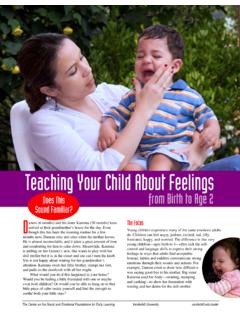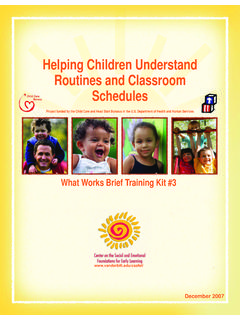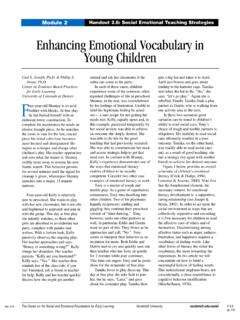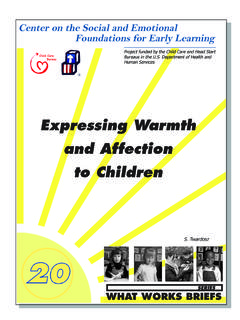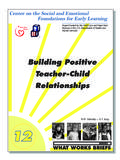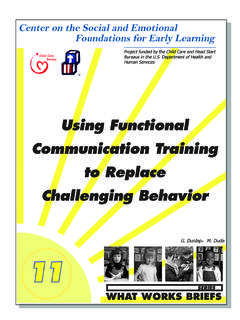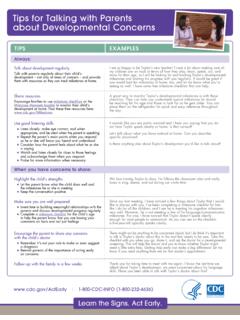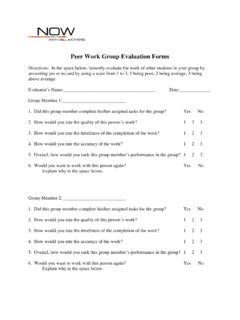Transcription of Teaching Your Child to: Identify and Express Emotions
1 Teaching Your Child to: Identify andExpressEmotionsThe Center on the Social and Emotional Foundations for Early Learning Vanderbilt University This Sound Familiar?Maggie is playing with her four-year-oldson. He selects a truck puzzle and beginsmatching and placing the pieces in theholes. He has a difficult time turning a piecearound so that it will match the hole and tells him, Let me help you turn it theright way. Her son pushes her hand away andsays in an agitated voice, Let me do it. Hetries to fit the piece in again, but isunsuccessful. He screams and throws the pieceacross the room and then throws the puzzle atMaggie.
2 What would you do if this happened in yourhome? Would you throw in the towel and quitfor the night, maybe try again tomorrow? ORwould you turn it around and create a brandnew lesson, about helping your childunderstand and talk about his Emotions ?The Center on the Social and Emotional Foundations for Early Learning Vanderbilt University Focus Young children deal with many of thesame Emotions adults do. Childrenget angry, sad, frustrated, nervous,happy, or embarrassed, but they oftendo not have the words to talk abouthow they are feeling. Instead, theysometimes act out these Emotions invery physical and inappropriate example, when Maggie s son wasfrustrated, he threw the puzzle pieceand the puzzle.
3 The Solution Parents can help their childrenunderstand and Express theiremotions. The following strategiesare some of the ways you can helpyour Child Express his feelings: Help your children understandtheir Emotions by first giving thefeelings names and thenencouraging them to talk abouthow they are feeling. Forexample, you might say to yourchild, Daddy left on a trip, youare sad. You said you want yourDaddy. By giving your Child alabel for her Emotions , you enableyour Child to develop a vocabularyfor talking about feelings. Give children lots of opportunitiesto Identify feelings in themselvesand others.
4 For example, youmight say to your Child , Ridingyour bike is so much fun. I see yousmiling. Are you happy? Or youmight point out a situation and askyour Child to reflect on whatsomeone else may be feeling: Joey bumped his head on theslide. How do you think Joeyfeels? Teach your children the differentways they can respond to specificfeelings, conflicts, or about your own feelings withyour children. Rememberyesterday when the water in thebathtub would not go down thedrain? Mommy got so mad and doyou remember what my face lookedlike when I got mad? Can youmake a mad face like Mommy s?
5 Talk with your children aboutdifferent ways you deal withspecific feelings. When I get mad Itake a deep breath, count to three,and then try to think of the best wayto deal with my problem. Teach your Child to Identify andexpress their Emotions in ways thatyour family and friends findacceptable. For example, you mighttell your Child SometimesGrandfather is angry when thingsdon t go well at work. What doeshe do? He sits on the porch until hefigures out what he wants to sayabout it. You should sit and thinkwhen you get angry. The Steps 1. Explain the feeling by using wordsyour Child can easily to use pictures, books, or videosto help get your point across.
6 Lookat Little Red Riding Hood s face;she is so scared when she sees thewolf in her Grandma s bed! 2. Teach your Child the different wayswe can deal with feelings. Let yourchild come up with ways she candeal with her feelings. Talk aboutpositive and not so positive ways toexpress feelings. There are manystrategies you can use to teach newways to appropriately expressfeelings: Use real-life examples or teach inthe moment. For example, Youare having a difficult time puttingyour trike in the carport. Youlook frustrated. What can youdo? I think you could ask forhelp or take a deep breath andtry again.
7 What do you want todo? Teach your Child new ways torespond to feelings by discussingcommon situations that yourchild might remember or thathappen frequently. For example, Yesterday, you were angrybecause Joey would not let youplay with his truck. You were somad that you hit him. When youfeel angry that Joey won t let youhave a turn, what should youdo? You can use children s books totalk about feelings. For example,ask your Child when reading abook, What is (character inbook) feeling right now? Howdo you know? Have you ever feltthat way? What do you do whenyou feel that way?
8 Keep it simple, use visuals orpictures to help get your pointacross, and always try to relateyour lesson back to somethingthat happens in your Child s life. Teach your Child new strategiesto use when feeling Emotions thatmay be expressed inappropriately( , anger, frustration, sadness).Strategies to share with yourchild might include taking a deepbreath when frustrated or angry,getting an adult to help resolve aconflict, asking for a turn whenothers won t share, asking for ahug when sad, and finding aquiet space to calm down Center on the Social and Emotional Foundations for Early Learning Vanderbilt University displayed.
9 It will taketime before your Child canbe creative with this you guess, ask yourchild to name what makeshim have that taking turns until yourchild shows you that he isnot interested in continuingthe a storyin a new way. Reada book to your Child that showscharacters who experience differentemotions ( , sad, happy, scared,worried, confused, etc.). Stop on apage where the character isshowing the expression. Ask yourchild What do you think he isfeeling? Why is he feeling thatway? or Look at her face, howcan you tell that she is __? Otherquestions could be Have you everfelt___?
10 What make you feel thatway? or What will happennext? or What should he do? Do not pause too long on one pageand only continue the discussion aslong as your Child shows an emotion bookwith yourchild. An easy project to do withyour Child is to create a homemadebook. All you need is paper,crayons or markers, and a can make a book about oneemotion and have your Child fill thepages with things that make herfeel that way. For example, a Happy Book may have picturesthat you and your Child draw ofthings that make her happy,pictures cut out of magazines thatare glued on the pages, orphotographs of friends and familymembers.

